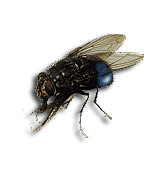General Characteristics:
- Eyes reddish; mouthparts sponging; dorsum of thorax with four narrow black stripes
- Adult body length 6-7 mm; female usually larger than male, larva 3-12 mm, pupa to 8 mm
- The thorax has the continuous dorsal suture across the middle
- Shiny with metallic coloring, often with blue, green, or black bodies
- Very similar to flesh flies (Sarcophagidae), some authorities place both in one family
Reproduction:
- A female requires a substantial amount of protein to develop mature eggs within her ovaries
- Blow-fly eggs, usually yellowish or white in color, are approximately 1.5 mm x 0.4 mm, and, when laid, look like rice balls
- The female blow-fly typically lays 150-200 eggs per batch
- The rate at which they grow and develop is highly dependent on temperature
- Hatching from an egg to the first larval stage takes about 8 hours to one day.
- Pupa will leave the corpse and burrow into the ground, emerging as an adult 7 to 14 days later.
Signs of Infestation:
- The larvae live in carrion, excrement and similar materials in heavily urbanized areas
- May be observed on the exterior walls of buildings
- Temperate to tropical areas that provide a layer of loose, damp soil and litter where larvae may thrive and pupate
- May be observed around rotting organic wastes
Control Techniques:
- Ensure all interior and exterior areas are sanitized and free of organic debris
- Close and seal as many openings as possible through which the flies can enter. This procedure is time consuming and may require a dedicated long term effort.
- Use a compressed air sprayer to apply a surface spray to surfaces in attics, basements, closets, store rooms and other areas where the flies congregate.
- Using a pyrethrin aerosol for treating cracks and crevices will compliment your surface spray
- Insecticides such as dusts, wet table powders, microencapsulated products, or aerosols may be used ACCORDING TO LABEL SPECIFICATIONS AND IN ACCORDANCE WITH FEDERAL, PROVINCIAL AND MUNICIPAL LAWS
Please click here to contact a Focus Pest Control professional to inquire about further treatments for this pest species.
References:
Whitworth, Terry (July 2006). "Keys to the Genera and Species of blow Flies (Diptera: Calliphoridae) of America North of Mexico". Proceedings of the Entomological Society of Washington 108 (3): 689–725. http://apt.allenpress.com/perlserv/?request=get-abstract&doi=10.1043%2F0013-8797%282006%29108%5B0689%3AKTTGAS%5D2.0.CO%3B2. Retrieved 2008-05-31.
“Family Calliphoridae - Blow Fly” (On-line). Iowa State University Entomology. Accessed Jan.
6, 2010 at http://bugguide.net/node/view/7175
Disclaimer:
The Focus Pest Control ‘Pest Library’ is an educational resource written largely to educate the general public about common pests in Ontario. The Focus ‘Pest Library’ does not include all species in Ontario, nor does it include the most recent scientific data about species we describe. Though we edit our accounts for accuracy, we cannot guarantee all information in those accounts. While Focus Pest Control staff and contributors provide references to books and websites that we believe are reputable, we cannot necessarily endorse the contents of references beyond our control.
(Back to top)
|


